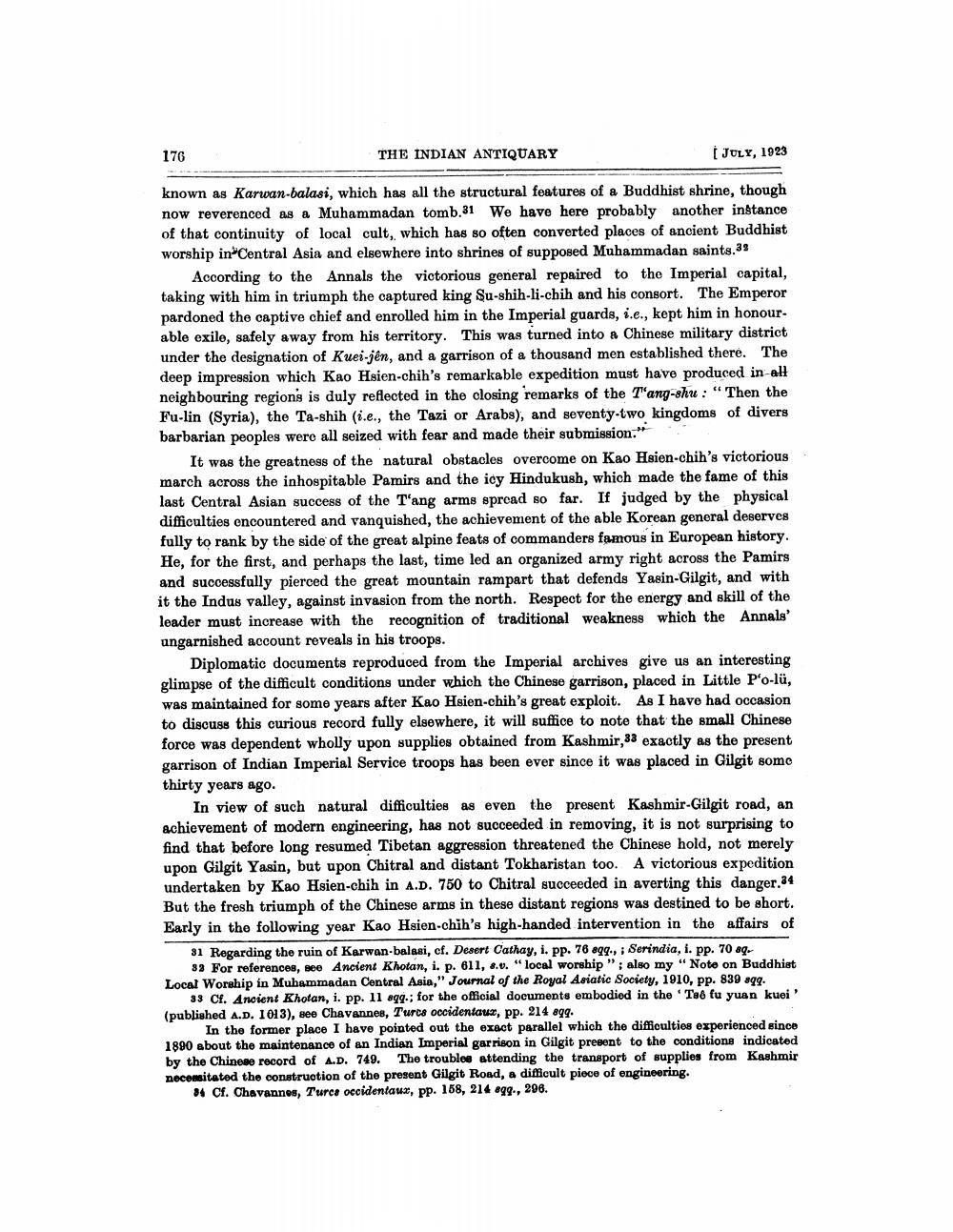________________
176
THE INDIAN ANTIQUARY
JULY, 1923
known as Karwan-balasi, which has all the structural features of a Buddhist shrine, though now reverenced as a Muhammadan tomb.31 We have here probably another instance of that continuity of local cult, which has so often converted places of ancient Buddhist worship in Central Asia and elsewhere into shrines of supposed Muhammadan saints.33
According to the Annals the victorious general repaired to the Imperial capital, taking with him in triumph the captured king Su-shih-li-chih and his consort. The Emperor pardoned the captive chief and enrolled him in the Imperial guards, i.e., kept him in honour. able exile, safely away from his territory. This was turned into a Chinese military district under the designation of Kuei-jên, and a garrison of a thousand men established there. The deep impression which Kao Hsien-chih's remarkable expedition must have produced in all neighbouring regions is duly reflected in the closing remarks of the T'ang-shu : " Then the Fu-lin (Syria), the Ta-shih (i.e., the Tazi or Arabs), and seventy-two kingdoms of divers barbarian peoples were all seized with fear and made their submission."
It was the greatness of the natural obstacles overcome on Kao Hsien-chih’s victorious march across the inhospitable Pamirs and the icy Hindukush, which made the fame of this last Central Asian success of the T'ang arms spread so far. If judged by the physical difficulties encountered and vanquished, the achievement of the able Korean general deserves fully to rank by the side of the great alpine feats of commanders famous in European history. He, for the first, and perhaps the last, time led an organized army right across the Pamirs and successfully pierced the great mountain rampart that defends Yasin-Gilgit, and with it the Indus valley, against invasion from the north. Respect for the energy and skill of the leader must increase with the recognition of traditional weakness which the Annals' ungarnished account reveals in his troops.
Diplomatic documents reproduced from the Imperial archives give us an interesting glimpse of the difficult conditions under which the Chinese garrison, placed in Little P'o-lü, was maintained for some years after Kao Hsien-chih's great exploit. As I have had occasion to discuss this curious record fully elsewhere, it will suffice to note that the small Chinese force was dependent wholly upon supplies obtained from Kashmir,33 exactly as the present garrison of Indian Imperial Service troops has been ever since it was placed in Gilgit somo thirty years ago.
In view of such natural difficulties as even the present Kashmir-Gilgit road, an achievement of modern engineering, has not succeeded in removing, it is not surprising to find that before long resumed Tibetan aggression threatened the Chinese hold, not merely upon Gilgit Yasin, but upon Chitral and distant Tokharistan too. A victorious expedition undertaken by Kao Hsien-chih in A.D. 750 to Chitral succeeded in averting this danger.34 But the fresh triumph of the Chinese arms in these distant regions was destined to be short. Early in the following year Kao Hsien-chih's high-handed intervention in the affairs of
31 Regarding the ruin of Karwan-balasi, cf. Desert Cathay, i. pp. 76 899., Serindia, i. pp. 70 sq.
89 For references, see Ancient Khotan, i. p. 611, 8.0. "local worship"; also my "Note on Buddhist Local Worship in Muhammadan Central Asia," Journal of the Royal Asiatic Society, 1910, pp. 839 sqq.
33 Cf. Ancient Khotan, i. pp. 11 -99.; for the official documents embodied in the 'Tee fu yuan kuei' (published A.D. 1013), see Chavannes, Turcs occidentaux, pp. 214 899.
In the former place I have pointed out the exact parallel which the difficulties experienced since 1890 about the maintenance of an Indian Imperial garrison in Gilgit present to the conditions indicated by the Chinese record of A.D. 749. The troublee attending the transport of supplies from Kashmir necesitated the construotion of the present Gilgit Road, a difficult piece of engineering.
84 Cf. Chavannes, Turcs occidentaux, pp. 188, 214 699., 296.




